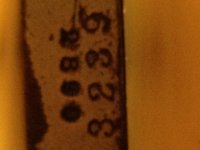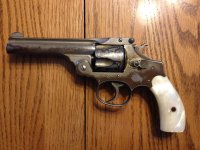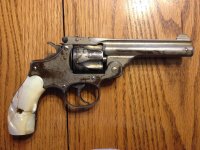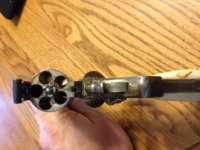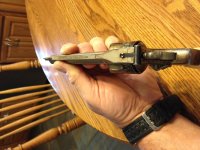I have a 38 S&W 5 shot Hand Ejector with exposed hammer that belonged to my Grandfather. It was nickel plated with pearl hand grips. The nickel finish is extremely worn and one side of the pearl hand grips is in 3 pieces. It has the thumb squeezer and a "V" rear sight on the break lever. I was just curious on the year and approximate value in it's current condition. Also if there might be a location that could reproduce the broken grip. I have attached some photos for your reference. The serial number may be 0685 3239 but the first 4 digits are hard to make out. There is a 2890 stamped on the back of the 5 shot cylinder. Any information would be appreciated.
-
Forum Update: We've upgraded the software to improve security, performance, and the overall experience.
👉 Read why we made the change | Support the Forum
You are using an out of date browser. It may not display this or other websites correctly.
You should upgrade or use an alternative browser.
You should upgrade or use an alternative browser.
S&W 38 Perfected Model
- Thread starter dahattok
- Start date
Register to hide this ad
- Joined
- Jun 28, 2007
- Messages
- 27,660
- Reaction score
- 21,275
Welcome! This is a .38 Perfected made between 1909-1920, a top break that (as you probably noted when opening the action) automatically ejects any chambered rounds. The HEs require pushing on the extractor rod to do this.
The four smaller digits on the bottom of the grip frame (6687?) are the true SN; the others might be an inventory or badge number. The number on the rear of the cylinder should match that one. Some different lighting or camera angle, or very light use of an abrasive to remove the rust, might bring the numbers out.
The stocks are aftermarket; you can probably find originals or replicas in black hard rubber. Others here will know the proper size; it may be the same as the I or .32 frame. It is fairly worn and may be a $300 gun or so. Hope this is helpful.
The four smaller digits on the bottom of the grip frame (6687?) are the true SN; the others might be an inventory or badge number. The number on the rear of the cylinder should match that one. Some different lighting or camera angle, or very light use of an abrasive to remove the rust, might bring the numbers out.
The stocks are aftermarket; you can probably find originals or replicas in black hard rubber. Others here will know the proper size; it may be the same as the I or .32 frame. It is fairly worn and may be a $300 gun or so. Hope this is helpful.
Alan
The picture shows that the OP misread the second number on the butt. He actually tried to read it upside down. It is 2890, the same number he says is on the rear face of the cylinder. Reading it upside down led to the idea it was "0685."
Added: I believe the other number is 3239, just as the OP said. That one reads the other direction.
The picture shows that the OP misread the second number on the butt. He actually tried to read it upside down. It is 2890, the same number he says is on the rear face of the cylinder. Reading it upside down led to the idea it was "0685."
Added: I believe the other number is 3239, just as the OP said. That one reads the other direction.
Last edited:
Welcome to the forum.
You have a wonderful family heirloom to shoot and enjoy, and past down thru the family.
.38 PERFECTED MODEL
Made from 1909 to 1920, serial # range 1 thru 59400, on the P frame. It has a .38 DA Top Break barrel and cylinder assembly but the same action and grip size concurrently used on the Model of 1903 32 Hand Ejector made on the I frame with a side swing cylinder.
The thumb latch in addition to the top latch takes two hands to open, and was designed to prevent a thug from reaching over the top of the gun, pulling the latch up and disabling the gun. S&W chose the Perfected name
to denote this model as the pinnacle of the top break design evolution, and back in the day, the term was a marketing fad word. Not unlike today's Smart word as in Smart Phone, etc.
You should be able to find a replacement genuine mother of pearl right side grip, in the classified section of this forum, on Ebay, or on Gunbroker.
Very likely there's another pair out there with the left side grip broken, and won't cost you so much. Any pre 1953 I frame or J frame grips are the same size as yours.
You have a wonderful family heirloom to shoot and enjoy, and past down thru the family.
.38 PERFECTED MODEL
Made from 1909 to 1920, serial # range 1 thru 59400, on the P frame. It has a .38 DA Top Break barrel and cylinder assembly but the same action and grip size concurrently used on the Model of 1903 32 Hand Ejector made on the I frame with a side swing cylinder.
The thumb latch in addition to the top latch takes two hands to open, and was designed to prevent a thug from reaching over the top of the gun, pulling the latch up and disabling the gun. S&W chose the Perfected name
to denote this model as the pinnacle of the top break design evolution, and back in the day, the term was a marketing fad word. Not unlike today's Smart word as in Smart Phone, etc.
You should be able to find a replacement genuine mother of pearl right side grip, in the classified section of this forum, on Ebay, or on Gunbroker.
Very likely there's another pair out there with the left side grip broken, and won't cost you so much. Any pre 1953 I frame or J frame grips are the same size as yours.
OLD GUN CLEANING AND SAFETY CHECK PROTOCOL FOR HEIRLOOMS & NEW GUN OWNERS:
Simply put, the only usual issue with these marvels of yesteryear is they are gummed up and dirty. Old oils of its time do not match the quality of these old guns nor the science of today, and actually dry up and harden to the point of impeding operation and accelerating wear. The simple solution does not need a gunsmith or removal of the side plate. Just one of many premium modern gun care products from any sporting goods, gun store or hardware store.
Most are both cleaning and preserving agents; Breakfree, Kroil & M-Pro7 are some of the best, and there are others, but do not use WD-40. Disassembly is not necessary. With grips removed and a spray can version of the product, flood and flush the revolver thru every opening and crevice until the black gunk stops flowing out, let it drain for an hour and wipe it down thoroughly with the same product.
Scrub barrel bore and cylinder chambers with a simple cleaning rod kit found at the same places as the cleaning agents above; patches cut from rags is all you really need. And scrub any observed exterior and crevice crud with an old toothbrush with bristles cut off short for stiffness.
You have a quality made, very well engineered, assembled with skilled craftsmanship, and hand fitted revolver, no longer affordable to produce on a competitive market basis, and the likes of which we'll never see again, ever.
To remove grips: loosen the grip screw completely and carefully push down on the screw head until the bottom grip separates, then remove. Now carefully push the top side grip off with a finger or toothbrush from the backside thru the grip frame.
The gun is now original and will never have greater value. I too would not refinish it and throw away all of the "character" acquired thru its life so far. It will only retain that value by retaining its originality. The only way to make it more original is to remove anything that it did not have on it when new, like any black tarnish or corrosion. Black and dark brown areas thru the blue, on bare metal or where nickel plating is worn off is very unsightly. Areas on nickel guns with no nickel plating left at all will polish bright and blend with remaining plating.
A careful polish with the correct products is the way to do that. Well known polishing products are Flitz, Semi-Chrome, Mother's Mag Wheel polish or the equivalent.
An application of wax, Renaissance wax is a popular one, will enhance and protect the finish if you want something to do while watching the news! if you want something to do while watching the news!
For rust spots, Blue Wonder cleaner will remove the rust but leave the bluing. Or use Bronze wool, not steel wool, size 0000 and toothbrush with bristles cut short, and a rust removing agent/gun cleaner like M-Pro 7 (odor free), Kroil or Breakfree and gentle scrubbing.
Rust pitting must have all red color removed to arrest it's cancerous growth (use 5x glasses or stronger to see progress). Then should be cleaned with acetone or lacquer thinner to remove all traces of oil. White areas of cleaned pitting can be 'toned down' and
touched up with OxPho Blue cream (from Brownells) and works best after heating the metal with a blow dryer until it’s too hot to touch. Actual rust pits in the surface can only be removed with a re-finish, but not always if too deep.
Once cleaned and lubricated, with a few simple checks you can determine if it’s safe to use; no need to waste time and money on a gunsmith, especially if you don't know one. Open the cylinder and verify the barrel is unobstructed. Cock the hammer in single action mode. Gently push on the hammer to confirm that it will not drop w/o pulling the trigger. Cock the hammer slowly and confirm the cylinder locks in position for each of the 6 chambers about the same time the hammer cocks. If satisfactory, now operate the gun in DA pulling the trigger slowly; again confirm the cyl locks before the hammer drops. After each cycling of the action, confirm that the cyl is still locked in position.
Cylinders can have fore and aft movement and rotational movement. Check rotational movement with the hammer cocked just to make sure it won’t skip to another chamber. That's all that is really important from a safety concern. Then unless you experience 'spitting' at the barrel/cyl gap when fired, you have no reason for concern.
You have a quality made, very well engineered, assembled with skilled craftsmanship, and hand fitted revolver, no longer affordable on a competitive market basis, and the likes of which we'll never see again, ever.
Shoot it to your hearts delight, and it will delight you with its fine accuracy, and comfortable recoil.
Any current off the shelf ‘standard’ factory loaded ammo is loaded safely for use in these old guns.
Simply put, the only usual issue with these marvels of yesteryear is they are gummed up and dirty. Old oils of its time do not match the quality of these old guns nor the science of today, and actually dry up and harden to the point of impeding operation and accelerating wear. The simple solution does not need a gunsmith or removal of the side plate. Just one of many premium modern gun care products from any sporting goods, gun store or hardware store.
Most are both cleaning and preserving agents; Breakfree, Kroil & M-Pro7 are some of the best, and there are others, but do not use WD-40. Disassembly is not necessary. With grips removed and a spray can version of the product, flood and flush the revolver thru every opening and crevice until the black gunk stops flowing out, let it drain for an hour and wipe it down thoroughly with the same product.
Scrub barrel bore and cylinder chambers with a simple cleaning rod kit found at the same places as the cleaning agents above; patches cut from rags is all you really need. And scrub any observed exterior and crevice crud with an old toothbrush with bristles cut off short for stiffness.
You have a quality made, very well engineered, assembled with skilled craftsmanship, and hand fitted revolver, no longer affordable to produce on a competitive market basis, and the likes of which we'll never see again, ever.
To remove grips: loosen the grip screw completely and carefully push down on the screw head until the bottom grip separates, then remove. Now carefully push the top side grip off with a finger or toothbrush from the backside thru the grip frame.
The gun is now original and will never have greater value. I too would not refinish it and throw away all of the "character" acquired thru its life so far. It will only retain that value by retaining its originality. The only way to make it more original is to remove anything that it did not have on it when new, like any black tarnish or corrosion. Black and dark brown areas thru the blue, on bare metal or where nickel plating is worn off is very unsightly. Areas on nickel guns with no nickel plating left at all will polish bright and blend with remaining plating.
A careful polish with the correct products is the way to do that. Well known polishing products are Flitz, Semi-Chrome, Mother's Mag Wheel polish or the equivalent.
An application of wax, Renaissance wax is a popular one, will enhance and protect the finish if you want something to do while watching the news! if you want something to do while watching the news!
For rust spots, Blue Wonder cleaner will remove the rust but leave the bluing. Or use Bronze wool, not steel wool, size 0000 and toothbrush with bristles cut short, and a rust removing agent/gun cleaner like M-Pro 7 (odor free), Kroil or Breakfree and gentle scrubbing.
Rust pitting must have all red color removed to arrest it's cancerous growth (use 5x glasses or stronger to see progress). Then should be cleaned with acetone or lacquer thinner to remove all traces of oil. White areas of cleaned pitting can be 'toned down' and
touched up with OxPho Blue cream (from Brownells) and works best after heating the metal with a blow dryer until it’s too hot to touch. Actual rust pits in the surface can only be removed with a re-finish, but not always if too deep.
Once cleaned and lubricated, with a few simple checks you can determine if it’s safe to use; no need to waste time and money on a gunsmith, especially if you don't know one. Open the cylinder and verify the barrel is unobstructed. Cock the hammer in single action mode. Gently push on the hammer to confirm that it will not drop w/o pulling the trigger. Cock the hammer slowly and confirm the cylinder locks in position for each of the 6 chambers about the same time the hammer cocks. If satisfactory, now operate the gun in DA pulling the trigger slowly; again confirm the cyl locks before the hammer drops. After each cycling of the action, confirm that the cyl is still locked in position.
Cylinders can have fore and aft movement and rotational movement. Check rotational movement with the hammer cocked just to make sure it won’t skip to another chamber. That's all that is really important from a safety concern. Then unless you experience 'spitting' at the barrel/cyl gap when fired, you have no reason for concern.
You have a quality made, very well engineered, assembled with skilled craftsmanship, and hand fitted revolver, no longer affordable on a competitive market basis, and the likes of which we'll never see again, ever.
Shoot it to your hearts delight, and it will delight you with its fine accuracy, and comfortable recoil.
Any current off the shelf ‘standard’ factory loaded ammo is loaded safely for use in these old guns.
. . . I was just curious on the year and approximate value in it's current condition. Also if there might be a location that could reproduce the broken grip . . .
Welcome to the Forum. You have one of the early examples of the 38 Perfected, probably manufactured the first year of production - 1909. As for value, condition is everything and as you stated, there is quite a bit of nickel missing. You could expect around $200 to $300 at auction. The spread is subjective, but I have seen similar condition guns going for that range of prices. There is some demand for these guns, since they are unusual and S&W last top-break model to be introduced. In a way, it is surprising that so many were made, but it is speculated that most may have gone to foreign markets where there was a greater interest in top-breaks than in the US.
Those Mother-of-Pearl stocks appear for sale quite often on ebay, but they would not have been original to the gun A distributor of prior owner installed them and removed the standard black hard rubber stocks that would have been installed at the factory. As for size, you can look over a Expert Commentary on this Forum. http://smith-wessonforum.com/blog.php?b=111 . The revolver frame is basically a Model 1903 Hand Ejector frame, or I frame, and any pre-war round-butt stocks will fit your gun. Also, 38 Double Action top-breaks wear the same size and design stocks.
Further reading about the 38 Perfected can be found on another Commentary if interested. http://smith-wessonforum.com/blog.php?bt=485
rhmc24
Absent Comrade
Similar threads
- Replies
- 18
- Views
- 2K

